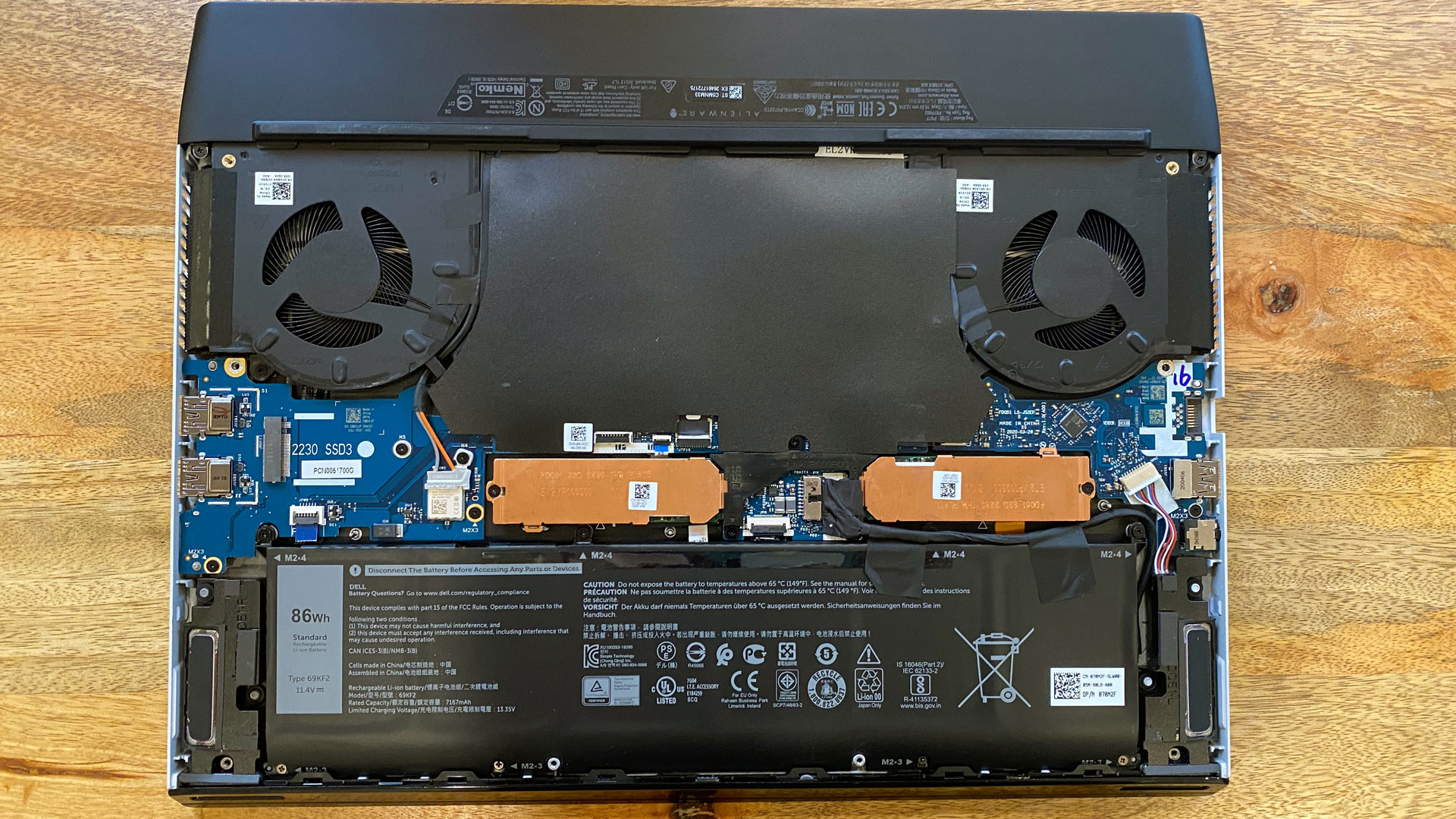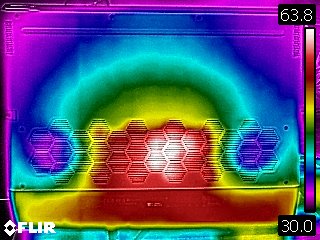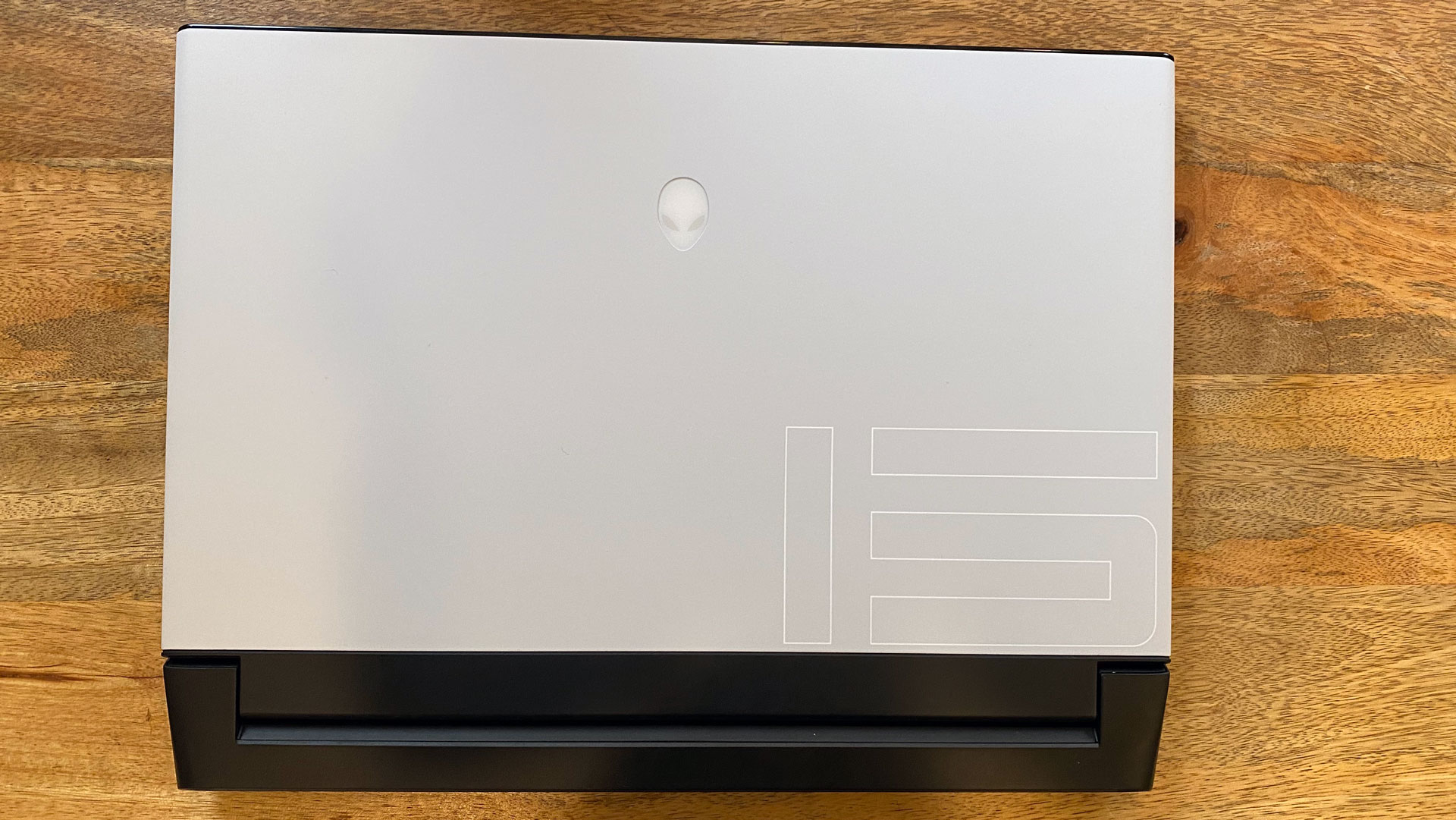Tom's Hardware Verdict
The Alienware m15 R3 is an attractive gaming machine with lots of expandability options and a 300 Hz screen for eSports, but it runs hot and that display hogs the battery.
Pros
- +
Attractive, sleek design
- +
Plenty of ports
- +
Strong gaming performance
- +
300 Hz display is great for eSports
Cons
- -
300 Hz display is a major battery drain
- -
Keyboard gets really warm
Why you can trust Tom's Hardware
As the best gaming laptops get thinner and lighter, the companies that make them are pushing new features to stand out and provide a competitive advantage. On the Alienware m15 R3 ($1,371.99 to start. $2,165.79 as tested), that includes options for a 300 Hz 1080p display or 4K OLED.
This year’s model also comes with Intel’s 10th Gen H-series processors, and, in our review unit, a full-sized Nvidia GeForce RTX 2070. That all makes the Alienware m15 R3 a portable, powerful eSports or AAA gaming machine. But the thin chassis does have some disadvantages, as it got hotter than we would like.
Alienware m15 R3 Design
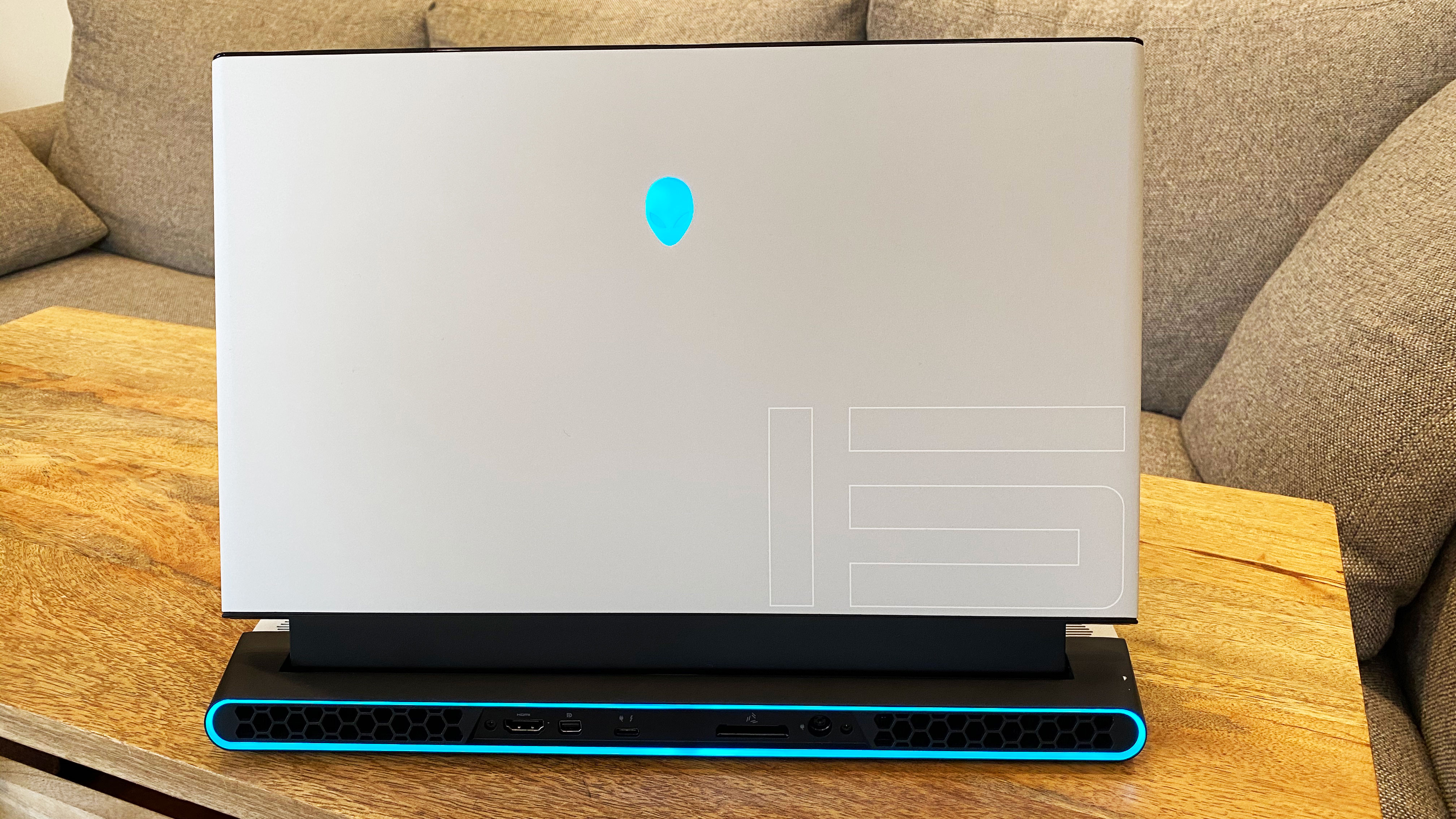
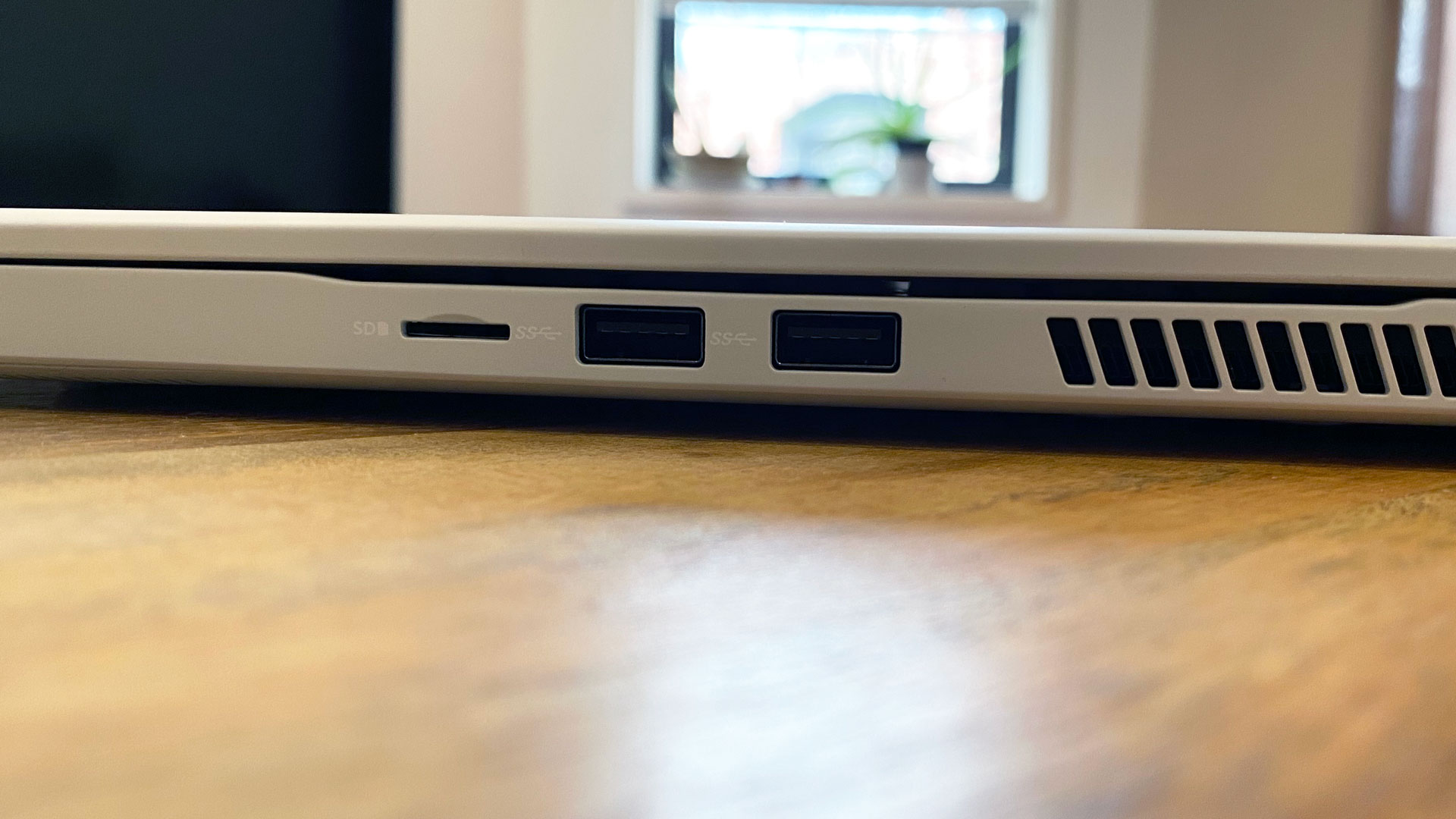

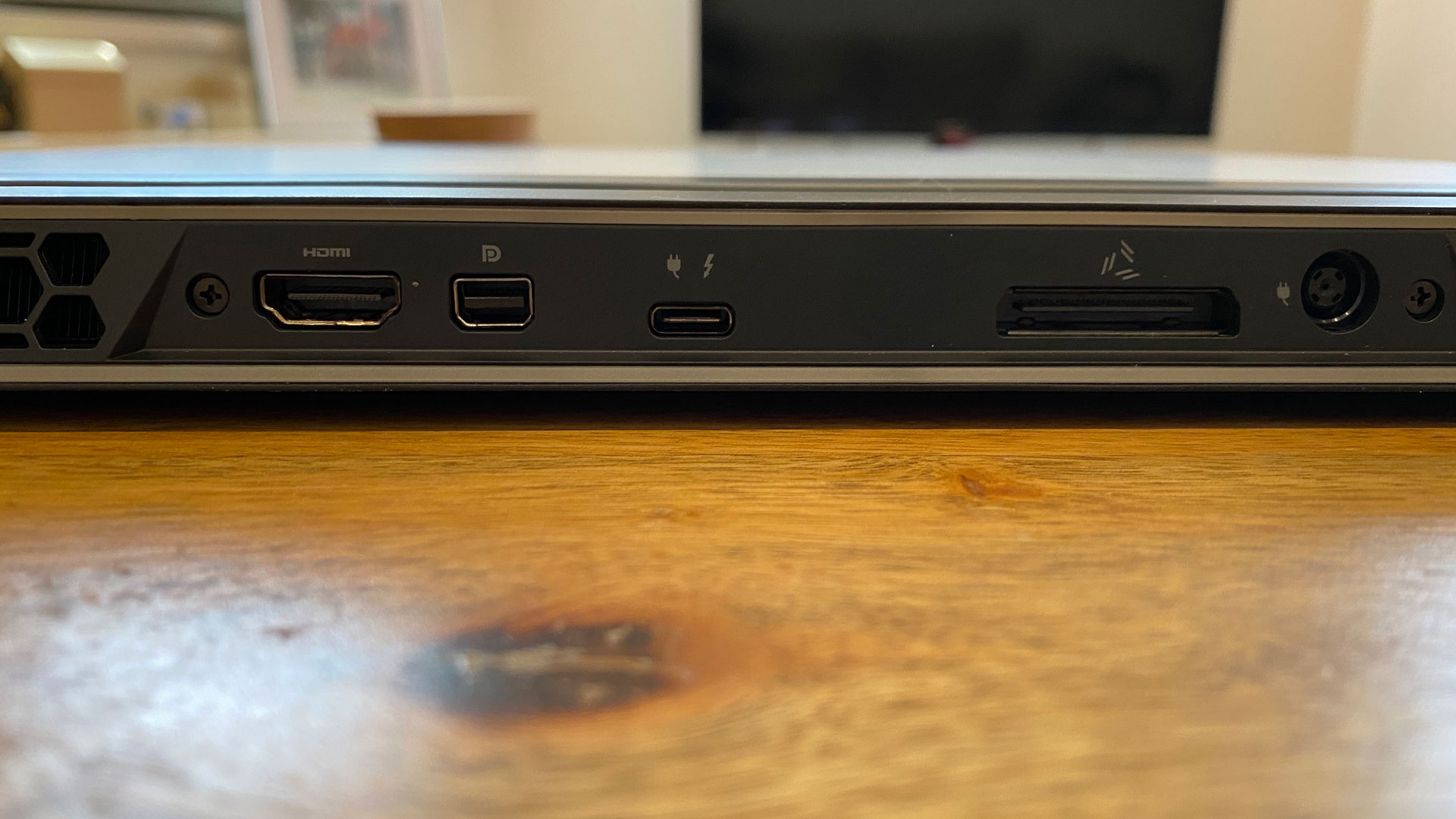
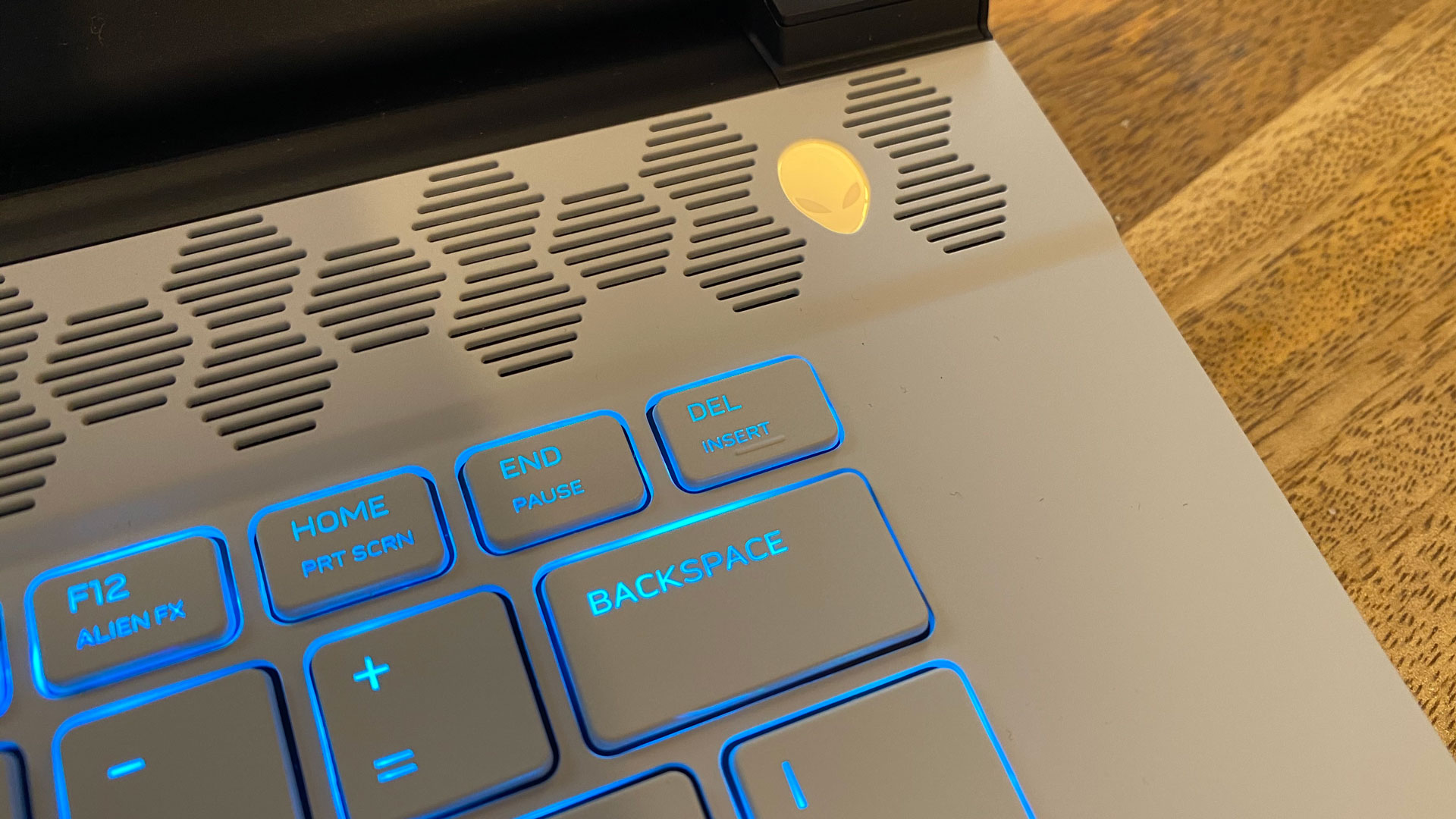
The Alienware legend aesthetic is in its second year, and the Alienware m15 R3’s design isn’t tiring just yet. It’s very similar to last year’s model, featuring a “lunar light” white lid with a soft-touch finish and, new for this year, an extra clear coat to ensure that it stays pristine (the laptop is also available in black). There’s a light-up Alienware logo and the number “15” in an aggressive, stenciled font on the lid.
A bump in the back holds cooling and ports with honeycomb designs over the vents that stand out, as well as an ovular light that looks futuristic, as if this thing could take off on its own at high speeds.
Our review unit, with a 300 Hz display, doesn’t have the Tobii eye tracking you can find on configurations with a 4K display. But the bezels are thin, and the screen stands on a centralized hinge that looks like it’s on a pedestal.
The deck on our model was also white, but with a splash of color, thanks to the per-key RGB keyboard. The honeycomb motif is continued here, with some ventilation just under the screen.
There’s ports-a-plenty on this laptop, with a bump on the back allowing them to be spaced out. The left side has the Ethernet jack, a USB 3.1 Type-A port and the headphone jack. Two more USB 3.1 ports and a microSD card reader are on the right side. On the back are all of the ports you may use with a display, including HDMI, Mini DisplayPort and Thunderbolt 3, as well as the power jack and proprietary Alienware graphics amplifier for external GPUs.
Get Tom's Hardware's best news and in-depth reviews, straight to your inbox.
The Alienware m15 R3 weighs in at 4.7 pounds and measures 14.2 x 10.9 x 0.8 inches. The Asus ROG Zephyrus M15 is a bit smaller at 4.2 pounds and 14.2 x 9.9 x 0.8 inches, while the MSI GS66 Stealth is also slightly smaller at 4.6 pounds and 14.2 x 9.7 x 0.7 inches. The Asus ROG Zephyrus G14, with a 14-inch screen, is 3.5 pounds and 12.8 x 8.7 x 0.7 inches.
Alienware m15 R3 Specifications
| CPU | Intel Core i7-10750H |
|---|---|
| Graphics | Nvidia GeForce RTX 2070 Super (8GB GDDR6) |
| RAM | 16GB DDR4 2666 MHz |
| SSD | 2x 512GB NVMe SSDs in RAID 0 |
| Display | 15.6-inch, 300 Hz, 1920 x 1080 |
| Networking | Killer Wi-Fi 6 AX1650 (2x2) 802.11ax Wireless, Bluetooth 5.1 |
| Ports | 3x USB 3.1 Type-A, Thunderbolt 3, RJ45 Ethernet, Alienware graphics amplifier, HDMI 2.0b, Mini DisplayPort, 3. mm headphone jack, lock slot, microSD card reader |
| Camera | 720p |
| Battery | 6-cell, 86 WHr |
| Power Adapter | 240W |
| Operating System | Windows 10 Home |
| Size | 14.2 x 10.9 x 0.8 inches (360.3 x 276 x 20.5mm) |
| Weight | 4.7 pounds (2.1 kg) |
| Price (as Configured) | $2,165.79 |
Alienware m15 R3 Gaming and Graphics
For gaming, our unit paired the Intel Core i7-10750H with a full-sized Nvidia GeForce RTX 2070 Super (no Max-Q business here). It proved to be a fairly potent combination. In conjunction with a 300 Hz display, this is a strong setup for esports, like Overwatch, in which I was able to hover around 250 fps while playing at 1080p on low settings in a Payload match, where I used Reinhardt’s shield to lead my team’s defense.
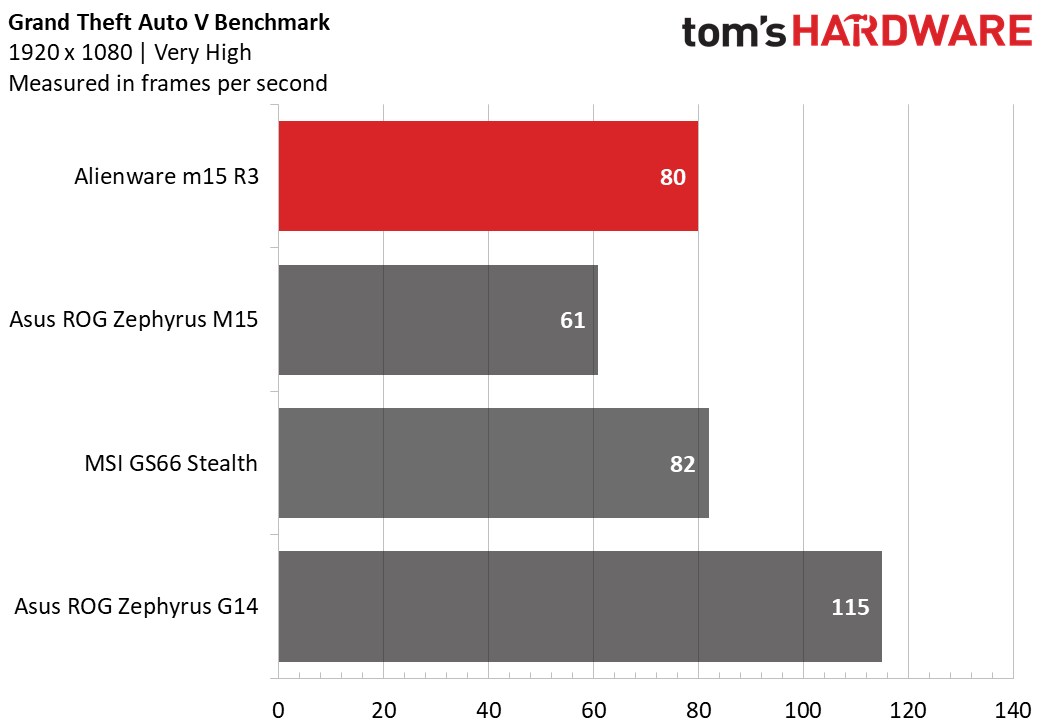
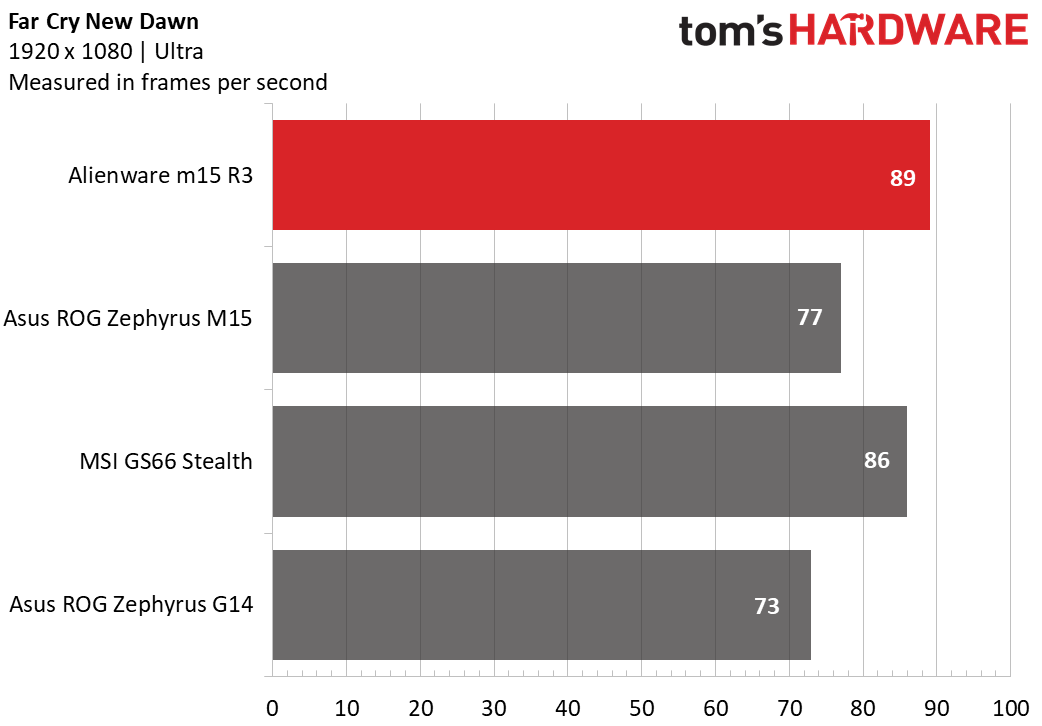
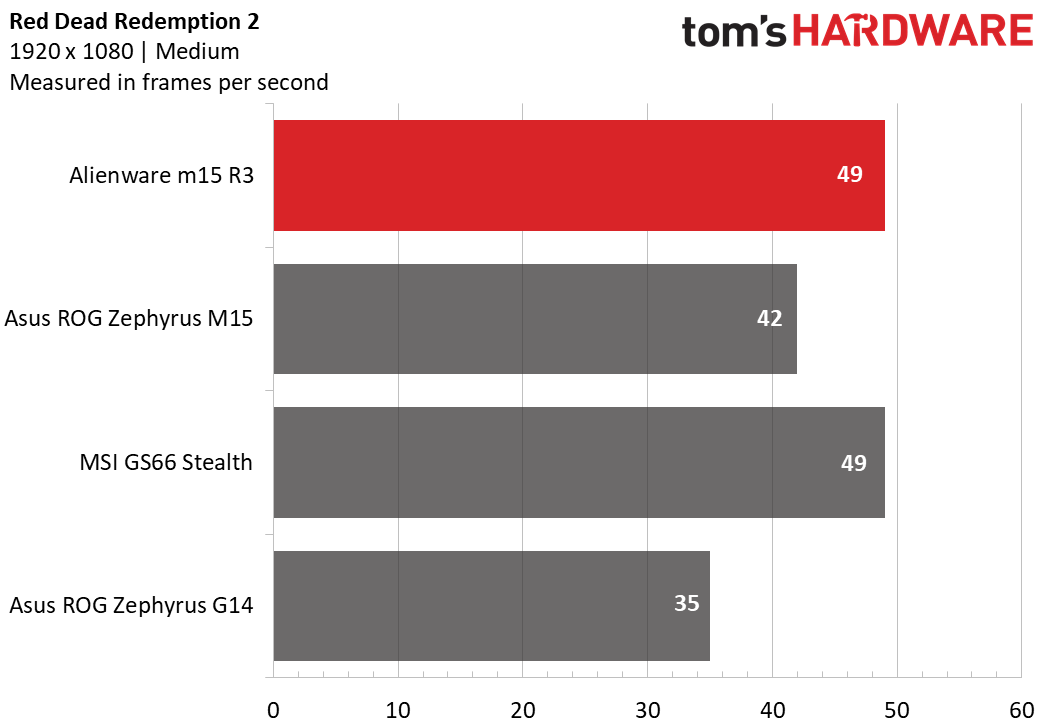
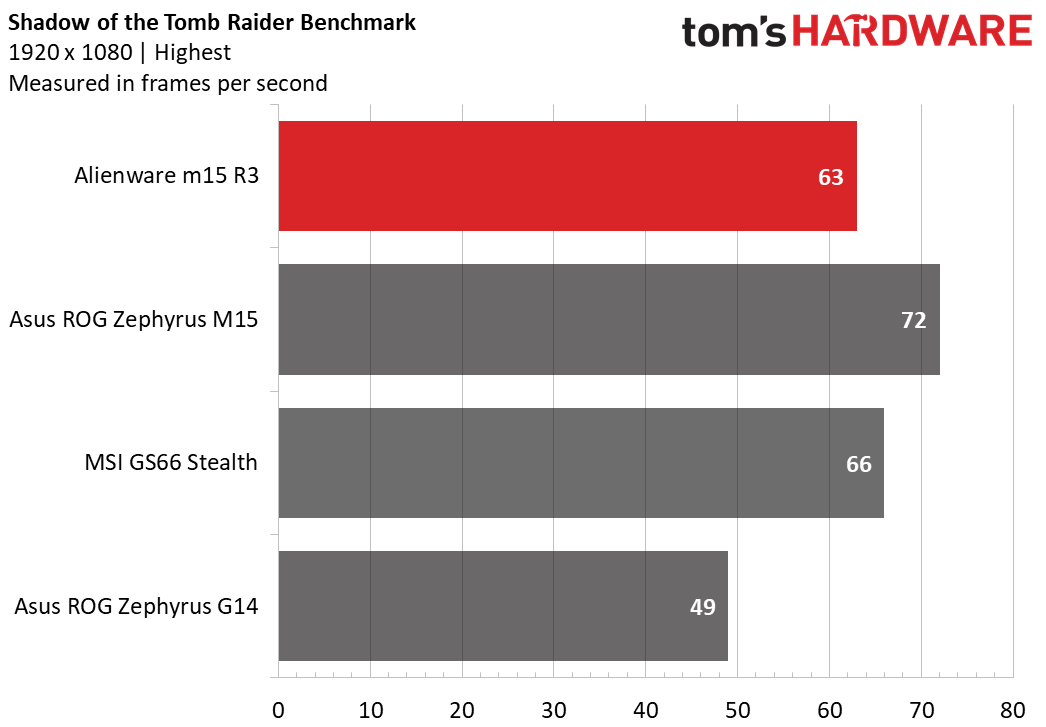
On Grand Theft Auto V (very high settings, 1080p), the Alienware notched an average score of 80 fps, falling only behind the Zephyrus G14 with a Ryzen 9 4900HS and RTX 2060. It barely lost to the GS66 (RTX 2080 Super Max-Q) but beat the Zephyrus M15 (GTX 1660 Ti).
The Alienware led the pack in Far Cry New Dawn (ultra, 1080p) at 89 fps, beating back the Stealth (86 fps), as well as both the G14 (73 fps) and M15 (77 fps).
Alienware and MSI tied on the Red Dead Redemption 2 benchmark (medium, 1080p), running the game at 49 fps. The M15 hit 49 fps, while the G14 ran it at 35 fps.
On Shadow of the Tomb Raider, the Stealth (66 fps) edged out the Alienware (63 fps).
We also stress tested the m15 by running the Metro Exodus benchmark 15 times on a loop at the RTX preset to simulate roughly half an hour of gaming. The laptop achieved an average frame rate of 48.2 fps. It started at 50 fps on the first run, dropped to between 47 fps and 48 fps until the last few runs, where it evened out at just over 48 fps.
The CPU ran at an average clock speed of 3.9 GHz and an average temperature of 88 degrees Celsius (190.4 degrees Fahrenheit). Our logging did note some thermal throttling across the runs. The GPU ran at an average of 1,390 MHz and an average temperature of 72.4 degrees Celsius (165.6 degrees Fahrenheit).
Alienware m15 R3 Productivity Performance
The Intel Core i7-10750H paired with 16GB of RAM and two 512GB NVMe SSDs in RAID 0 mean that the Alienware m15 isn’t a slouch when it comes to productivity performance. What? You thought gaming laptops could only play games?
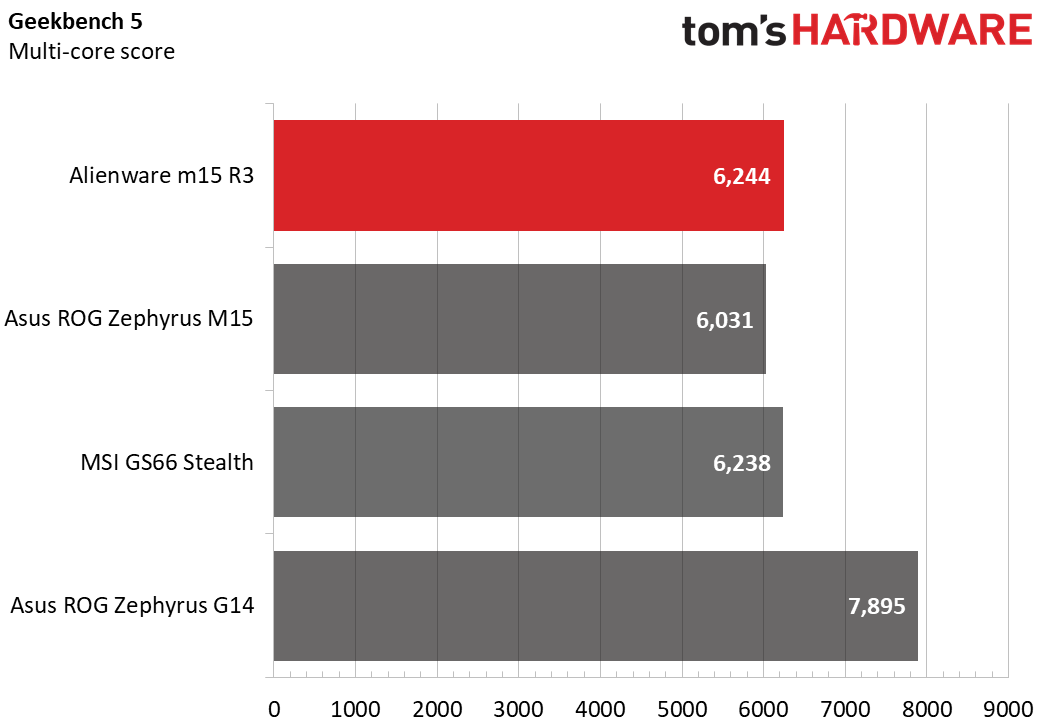

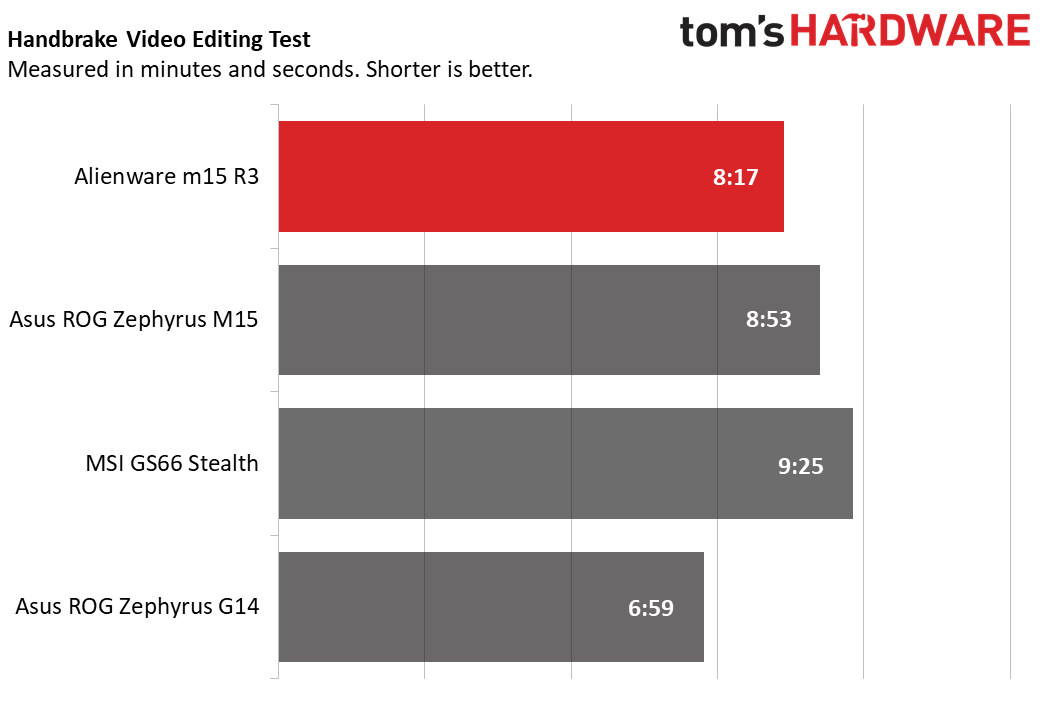
On Geekbench 5.0, the Alienware m15 R3 earned a multi-core score of 6,244, just beating the MSI GS66 Stealth (6,238) and the Asus ROG Zephyrus M15 (6,031), each with the same processor. The Asus ROG Zephyrus G14, with an AMD Ryzen 9 4900HS, outperformed at 7,895.
Our file transfer test requires computers to copy 4.97GB of files. The Alienware, with its dual SSDs in RAID0, reached speeds of 1,209.91 MBps. That’s similar to the Zephyrus G14, but far faster than the Zephyrus M15. The Stealth completed the test the fastest.
It took the Alienware m15 8 minutes and 17 seconds to transcode a 4K video to 1080p using Handbrake. That’s ahead of both the Zephyrus M15 and the GS66 stealth, but the Zephyrus G14 was even faster.
Alienware m15 R3 Display
Alienware’s 15.6-inch, Full HD display comes armed with 300 Hz speeds, though it’s also pretty solid for more casual computing. For instance, when I watched a 1080p trailer for Hamilton on Disney Plus, the colorful colonial clothes, including blue soldier’s jackets with red accents, popped out against a dark stage. I do, wish, however, that the screen would get brighter. When I played Overwatch, the game was incredibly smooth at 250 fps thanks to the display, but the colorful levels would have looked even better if they were brighter.
According to our testing, the m15 R3 covers 77.4% of the DCI-P3 color gamut, which is far better than the Zephyrus M15’s 46% and on par with the Stealth’s 79%. The Asus ROG Zephyrus G14 was higher at 82.9%.
Brightness was a different story. Our review machine measured an average of 285 nits, beating the Zephyrus M15 (234 nits) but falling behind both the Zephyrus G14 and MSI GS66 Stealth.
Alienware m15 R3 Keyboard and Touchpad
Alienware’s keyboard offers 1.7mm of travel and is nice and clicky. On the 10fastfingers.com typing test, I zoomed along at 110 words per minute with my standard 2% error rate. On our model, the keys were individually backlit, though that’s an upgrade. The laptop comes standard with four lighting zones. My only complaint is that when the computer is under stress, the keyboard can get far warmer than I would like.
The 4.2 x 2.4-inch touchpad could stand to be a little larger. It’s big enough for navigating Windows 10, but I personally like something a bit bigger. Thanks to Windows precision drivers, I had no problem with gestures.
Alienware m15 R3 Audio
The speakers on the Alienware m15 R3 get nice and loud, though they’re not the most detailed. I blasted Halsey’s “Without Me,” and it easily filled my apartment. But the singer’s voice definitely overpowered the synths and drum beat during the chorus. When I opened up Alienware Command Center, I found that the music preset allowed for a slightly more even mix.
For gaming, Overwatch got so loud I had to turn it down. The characters’ calls for healing were clear over the gunfire and lasers, though most music wasn’t as vibrant as it is from real speakers.
It can be distracting to play music while you type, though, as the speakers are located in the wrist rest and reverberated through the chassis.
Alienware m15 R3 Upgradeability
Getting the Alienware m15 R3 open is easy enough. Of the eight Phillips head screws on the bottom of the unit, only the two closest to the back need to be removed completely. The rest simply loosen, decreasing the chance you’ll lose a bunch of screws. You’ll need a spudger or pry tool to get the base off, but it’s not on too tight.
When you get in, you’ll notice that only the battery and SSDs are easily accessible. Since we had a unit with dual 512GB drives, both slots were occupied and covered with copper heatsinks. If you get a single drive, you’ll need to remove the second heatsink to add more storage space. The RAM, sadly, is soldered to the motherboard.
Alienware m15 R3 Battery Life
Out of the box, the Alienware m15 R3 had low endurance. It lasted for 2 hours and 39 minutes on our battery test, which continuously browses the web, streams video and runs OpenGL benchmarks all at 150 nits over Wi-Fi.
Here’s the catch: that’s likely because the laptop was exclusively using the Nvidia RTX 2070 GPU. Alienware’s 300 Hz panel requires the RTX GPU, so it doesn’t switch to Intel’s integrated graphics. Other configurations without this panel allow for the use of integrated graphics.
The MSI GS66 Stealth endured for 6:36, while the Asus ROG Zephyrus M15 ran for 7:32. The Asus ROG Zephyrus G14 lasted the longest at 11:32, which is incredible for a gaming notebook.
Alienware m15 R3 Heat
We took skin temperature measurements while running our Metro Exodus benchmark and found that the machine gets quite toasty while playing intense games.
The center of the keyboard, between the G and H keys, measured a steamy 51.7 degrees Celsius (125.1 degrees Fahrenheit), which explains why the laptop was sometimes uncomfortable to use while it was under load. The touchpad hit 36.9 degrees Celsius (98.4 degrees Fahrenheit).
The hottest point on the bottom of the laptop reached 63.8 degrees Celsius (146.8 degrees Fahrenheit), which is quite hot. Keep this one on your desk.
Alienware m15 R3 Webcam
There’s a 720p webcam right above the display, and let me tell you, it makes a grainy image. In a picture I took in a well-lit area of my apartment, I could see the individual pixels making up my face. It’s not pretty. At least colors, like the blue of a teapot behind me (did I take a picture near my kitchen? You bet I’m working from home), were accurate.
Alienware m15 R3 Software and Warranty
Alienware adds software with a light touch, and most of the utilities that come with the laptop are renamed versions of applications you find from its parent company, Dell.
Alienware Command Center is the big name here. This app serves as a central location to launch games, change thermal and audio settings, adjust RGB lighting and see CPU and GPU usage.
My Alienware is a bit of a waste, with some Windows tips and links to the company's social profiles and attempts to sell accessories.
Alienware Mobile Connect lets you see notifications and even mirror smartphone app screens, which others haven’t been able to match just yet.
Of course, the laptop also came with bloat built into Windows 10, including Hulu, Hidden City: Hidden Object Adventure, PicsArt Photo Studio and Adobe Photoshop Express.
Alienware sells the m15 R3 with a 1-year warranty.
Alienware m15 R3 Configurations
We reviewed a $2,165.79 version of the Alienware m15 R3 with an Intel Core i7-10750H, Nvidia GeForce RTX 2070 Super, 16GB of RAM, a pair of 512GB NVMe SSDs in RAID0 and a 15.6-inch, 300 Hz FHD display. Ours also came in white, which is a roughly $30 extra cost.
The base model runs for $1,371.99 and has the same CPU and RAM. For that price, you get an AMD Radeon RX 5500M as your GPU and a 256GB NVMe SSD, plus a 144 Hz, FHD display. For $1,469.99, you get this model with an Nvidia GeForce GTX 1660 Ti. These versions only come in black.
The top-end configuration uses an Intel Core i9-10980HK, Nvidia GeForce RTX 2080 Super Max-Q, an OLED 4K display, 32GB of RAM, Tobii eye tracking, a pair of 2TB PCIe M.2 SSDs in RAID 0 as a boot drive and a 512GB PCIe M.2 SSD for storage. That costs $3,978.79.
Bottom Line
The Alienware m15 R3 is still among the sleekest gaming PCs out there, with a slimmed-down design that strays from the gamer aesthetic but doesn’t eschew it altogether. The option for a 300 Hz display is a boon for eSports players, though it won’t make as meaningful a difference for those who stick to high-end, big budget titles. It’s also a bit of a battery hog.
The full-sized RTX 2070 Super does a great job with games, on par or better than the MSI GS66 Stealth’s RTX 2080 Max-Q. Both machines have the same processor and tend to run quite warm. But with its 144 Hz panel, the Stealth offers better battery life (a 1080p 144 Hz option of this PC would also likely offer far more endurance).
If you want better CPU performance, the cheaper Asus ROG Zephyrus G14 with AMD’s Ryzen 9 4900HS is a better pick, but you can’t get that with a 300 Hz screen, and it only goes up to an RTX 2060.
For those looking for pure power, the Alienware m15 R3 delivers. Just be ready for a bit of heat.

Andrew E. Freedman is a senior editor at Tom's Hardware focusing on laptops, desktops and gaming. He also keeps up with the latest news. A lover of all things gaming and tech, his previous work has shown up in Tom's Guide, Laptop Mag, Kotaku, PCMag and Complex, among others. Follow him on Threads @FreedmanAE and BlueSky @andrewfreedman.net. You can send him tips on Signal: andrewfreedman.01
-
King_V Reply300 Hz display is great for eSports
No it's not. Not until humans develop cybernetic eyes. -
roblittler77 Reply
Actually yes it is, the higher the refresh rate the sooner information gets to your eyes and your brain can act on it, like with anything there are diminishing returns, but there is a measurable difference.King_V said:No it's not. Not until humans develop cybernetic eyes. -
King_V Reply
Diminishing returns are true - within human physical capability. 300Hz is well beyond that.roblittler77 said:Actually yes it is, the higher the refresh rate the sooner information gets to your eyes and your brain can act on it, like with anything there are diminishing returns, but there is a measurable difference. -
LordConrad I have a m15 R3, ordered it on release day. The RAID 0 drives are m.2 SATA, while the single "storage" drive is NVMe (x2 PCIe 3.0). First thing I did is change the boot drive to the single NVMe drive. What stupid company sets a RAID 0 array as a boot drive?Reply -
JarredWaltonGPU Reply
Eh, I don't really think so (the part about 300Hz being "well beyond that" -- I definitely agree with the diminishing returns aspect). Like, watching a video at 144Hz vs. 240Hz vs. 300Hz (and an accompanying framerate), I don't think anyone would notice. That's because cameras and video capture and then replay things in a different fashion.King_V said:Diminishing returns are true - within human physical capability. 300Hz is well beyond that.
But playing a game, with the live feedback loop, there's certainly a difference between 60Hz and 144Hz, and even from 144Hz to 240Hz. I suspect for serious (ie, 'pro' gamers like Ninja), yes, 300Hz and 300 fps vs. 240Hz and 240 fps would actually yield a modest 3-5% improvement. It's fuzzy math for sure, and no pro gamer is actually going to use a 15-inch laptop for a competition. There's a reason pros have standardized on 24-inch (sometimes 21.5-inch) displays. -
nofanneeded Older Alienware keyboard was better. Heat was lower as well. I dont like their new Design at all.Reply
The same can be said about the Desktops. -
Jim90 Ah...the olde Hz discussion. Perhaps a nod to that other critical factor, FPS, would be in order? - a high Hz will be increasingly pointless if there's a significant FPS imbalance there! What's also hugely significant is that the drive for high Hz does, by definition, lock the gamer to a 'low' resolution experience in the vast majority of cases - unless you're happy to knock down eye candy also. Add to that the requirement to purchase a top end gfx card and CPU.Reply
For the vast majority of us, operating outside the 'pro-gamer' scene, spending that money would be accompanied with higher resolution gaming as the primary goal. Of course, ultimately, every one of us (pro-gamer included) would like a combined experience of max res gaming, max FPS and max Hz, withing 'diminishing returns' reason. Tag a future VR experience to that for that final touch. -
escksu Replyroblittler77 said:Actually yes it is, the higher the refresh rate the sooner information gets to your eyes and your brain can act on it, like with anything there are diminishing returns, but there is a measurable difference.
https://humanbenchmark.com/
Try this... See whats your reaction time. Your clicking reaction time is easily over 100ms. Way higher than even 60Hz refresh rate of ~17ms.
We also need to include lag.....haha.... internet connection speed. 20-30ms is considered very good.
Higher refresh rate is not about getting information to your eyes sooner, its about motion looking smooth and not jerky. Of course, your GPU has to be able to keep up. If your game is running at only 50fps, then having a 300Hz display isn't going to do anything. -
dmylrea Reply
I've seen/used both 144hz and this m15 R3 w/300hz. Yes, you can see a difference. On the 300hz display, just moving windows around the screen is amazingly smooth, unlike anything you've seen. The difference is very noticeable.gg83 said:Can you really notice the difference between 144hz and 240?


